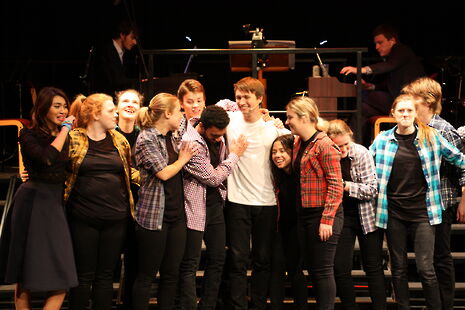Review: Joseph and the Amazing Technicolor Dreamcoat
Thomas O’Connor enjoyed aspects of the production, particularly the performances of the lead roles, but highlights the need for adjustments with the acoustics

Way, way back, many centuries ago (1968), Lloyd Webber and Tim Rice wrote a little show for a school concert. Having been produced many, many times since, Joseph and the Amazing Technicolor Dreamcoat has never really escaped its origins as a piece of musical juvenilia designed to be performed by children.
Brickhouse Theatre Company’s version at Robinson Auditorium stays firmly in the realms of a jolly and colourful semi-staged concert rather than a fully fleshed theatrical production. With some very strong cast members, bundles of enthusiasm, and a chorus of fantastic children, the familiar songs are churned out . The story revolves around the biblical exploits of Joseph (the eternally smiley and charismatic Harry Normanton), his brothers (in this case augmented by sisters), and his apparently amazing coat of red and yellow and indigo, etc.
Harry has the charm and the strength to keep the entire evening on track. Playing a role that could have been written for him, he sings acts and dances to perfection. He even manages to look pleased with the rather tatty coat the costume department have lumbered him with. He transitions from the daydreaming youth to the man of power, staying in character and delivering the lyrics with great clarity and emotion. Jodie Russell is the narrator, and is a wonderful match for Normanton, vocally and dramatically. She has a confident and engaging style, as she works her way around the stage, filling in the storyline and propelling the action onwards.
The large band dominates the evening, physically and acoustically. Taking up the bulk of the small stage, and set on raised decking, the band towered over the performers, and unfortunately, at times drowned out their vocals. This wasn't helped by the apparent lack of sound design: there was no attempt to balance the volume of the vocals among the singers, or between the singers and the band. Russell’s narrator was particularly let down by this, and her gorgeous voice and fun delivery were lost beneath the over amplified music. At many points it seemed that her microphone simply wasn’t working. However well the percussionist may play the wooden blocks, we really don’t want to hear them overpowering the score, tapping way above the overly loud band, and the poorly microphoned principals. The potentially delightful solos of the brothers suffered from the sound design, with the vocals of some of these performance totally lost.
There were some curious casting decisions. When casting the brothers as female, or the same actor in all the patriarchal roles, there is huge scope for inventive directing and playfulness. Such opportunities were missed, as was the chance to give the production any overall concept or sense of setting. The set consisted of little more than the bandstand, fronted by some large steps. With such a small stage area, these steps could have been employed cleverly to enhance the staging, but they largely remained unused. They did, however, provide seating for the small group of performers who brought the ‘Ahh Factor’ to the show: a children's chorus (from Stagecoach Performing Arts School). These kids were full of charm and excitement, had great voices and engaged with the show fully, lapping up every detail from the narrator.
The lack of discipline among some cast members during the final chorus numbers was really unacceptable and reduced the conclusion of the show to the level of a pre-school nativity. But with a narrator and a Joseph of this quality, much can be forgiven. They both embody the charisma and the performance to make the evening enjoyable. Even if the show ends with endless and unnecessary repeats of most of the show’s score, we still leave humming at least one of the tunes, and trying to reel off all the coat’s colours in order
 Comment / Anti-trans societies won’t make women safer14 November 2025
Comment / Anti-trans societies won’t make women safer14 November 2025 News / Controversial women’s society receives over £13,000 in donations14 November 2025
News / Controversial women’s society receives over £13,000 in donations14 November 2025 News / John’s rakes in £110k in movie moolah14 November 2025
News / John’s rakes in £110k in movie moolah14 November 2025 Fashion / You smell really boring 13 November 2025
Fashion / You smell really boring 13 November 2025 Music / Three underated evensongs you need to visit14 November 2025
Music / Three underated evensongs you need to visit14 November 2025









